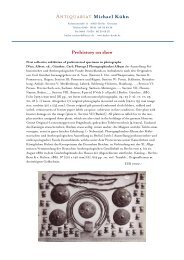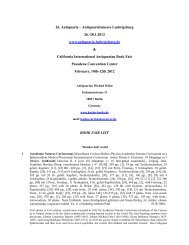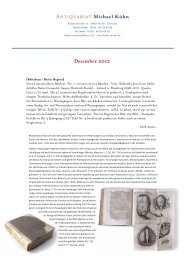List New York Antiquarian Book Fair - Antiquariat - Michael Kühn
List New York Antiquarian Book Fair - Antiquariat - Michael Kühn
List New York Antiquarian Book Fair - Antiquariat - Michael Kühn
You also want an ePaper? Increase the reach of your titles
YUMPU automatically turns print PDFs into web optimized ePapers that Google loves.
galvanometer by compa-ring the original technique of Waller, employing Lippmann’s capillary galvanometer,<br />
and the results of his own improvement of this method with the tracings obtained with the new de-vice. His<br />
report is illustrated with the first modern ECG recording and with the customary P, Q,R,S,T notation. Einthoven<br />
was born in Semarang, Java, in 1860. When he was six years of age his father, a physician, died and the family<br />
moved to Utrecht. There Einthoven entered medical school in 1879 and received his degree in medicine with<br />
distinction six years later. He was appointed professor of physiology in Leiden in 1886. Stimulated by the work<br />
of Au-gustus Waller, he started to improve on the techniques for recording the electrical signals of heartbeat. His<br />
work not only improved previous methods but eventually also led to the deve-lopment of a new instrument, the<br />
string galvanometer, for which he received the Nobel Prize in Medicine in 1924. He died in 1927.- Gedeon.<br />
Science & Technology in Medicine. 99 landmark publications. No. 71.<br />
Willem Einthoven (1860 – 1927) was a Dutch doctor and physiologist. He invented the first practical electrocardiogram<br />
(ECG or EKG) in 1903 and received the Nobel Prize in Medicine in 1924 for it. Before Einthoven's<br />
time, it was known that the beating of the heart produced electrical currents, but the instruments of the time<br />
could not accurately measure this phenomenon without placing electrodes directly on the heart. Beginning in<br />
1901, Einthoven completed a series of prototypes of a string galvanometer. This device used a very thin filament<br />
of conductive wire passing between very strong electromagnets. When a current passed through the filament, the<br />
electromagnetic field would cause the string to move. A light shining on the string would cast a shadow on a<br />
moving roll of photographic paper, thus forming a continuous curve showing the movement of the string. The<br />
original machine required water cooling for the powerful electromagnets, required 5 people to operate it and<br />
weighed some 600 lb. This device increased the sensitivity of the standard galvanometer so that the electrical<br />
activity of the heart could be measured despite the insulation of flesh and bones. Although later technological<br />
advances brought about better and more portable EKG devices, much of the terminology used in describing an<br />
EKG originated with Einthoven. His assignment of the letters P, Q, R, S and T to the various deflections is still<br />
used. The term "Einthoven's triangle" is named for him. It refers to the imaginary inverted equilateral triangle<br />
centered on the chest and the points being the standard leads on the arms and leg. After his development of the<br />
string galvanometer, Einthoven went on to describe the electrocardiographic features of a number of<br />
cardiovascular disorders. Later in life, Einthoven turned his attention to the study of acoustics, particularly heart<br />
sounds which he researched with Dr. P. Battaerd.<br />
Natural history of the evil<br />
[Feyerabend, Sigmund; editor] Theatrum Diabolorum, Das ist: Ein Sehr nutzliches verstenndiges<br />
Buch, darauß ein jeder Christ, sonderlich unnd fleissig zu lernen, wie daß wir in<br />
dieser welt nicht mit Keysern, Königen, Fürsten und Herrn, oder andern Potentaten, sondern<br />
mit dem allermechtigsten Fürsten dieser Welt, dem Teuffel zu kempffen und zu streiten. Die<br />
Namen der Authoren und Scribenten findet man verzeichnet nach der Vorrede. Gebessert und<br />
gemehret, mit einem newen Pestilentz Teufel, so zuvor noch nie in Truck außgangen, sampt<br />
einem nutzlichen Register.- Franckfurt am Mayn, Peter Schmid für Hieronymus Feyerabend,<br />
1569. Folio [340 x 230 mm]. 6 unn., 542 num., 5 unn. Blätter [ff.] m. Holzschnitt a. Titel u.<br />
Holzschnitt-Druckermarke v. Jost Am-man a. Schluß. Blindgeprägter Schweinsleder-holzdeckelband<br />
d. Zt m. 2 Messingschließen, etwas berieben u. bestoßen. $ 9400.-<br />
First edition of this compilation of different authors to all sort of devils: a natural history of evil. “The most<br />
curious work of protestant demonology is the Theatrum Diabolorum by Sigmund Feyerabend, a voluminous<br />
collection of the views of Luther’s followers concerning the existence, power, nature and demeanor of devils.<br />
Luther’s belief in the Devil was crude, but he was even here morally great, strong in his religious sentiment, and<br />
serious in his demand that every one personally should honestly wage a war with the powers of evil, and that no<br />
church, no intercession of saints, no formulas or rituals had any saving powers. Luther’s followers retain all the<br />
crudities of their master and to some extent his moral seriousness, but they fall below the manliness of his spirit.<br />
Feyerabend’s Theatrum, which, as the title says, is a useful and sensible book, contains a great number of essays<br />
written by such prominent authorities as Jodocus Hockerus, Hermann Hamelmann, Andreas Musculus, Andreas<br />
Fabricius, Ludovicus Milich, and others. The Reverend Hocker explains in 48 chapters almost all possible<br />
problems connected with devils whose number is [Chapter VII], according to Borrhaus, calculated to be not less<br />
than 2.665.866.746.664. Others describe special kinds of devils, such as the devil of blasphemy, dance-devil, the<br />
servant’s devil, the hunting devil, the drink-devil, the wedlock-devil, the devil of tyranny, the laziness devil, the<br />
devil of unchastity, the miser’s devil, the pride devil, the pantaloon devil, the gambling devil, the courtier’s devil,<br />
and the pestilence devil. The author of the last chapter, Rev. Hermann Strack, concludes by saying: “When we








